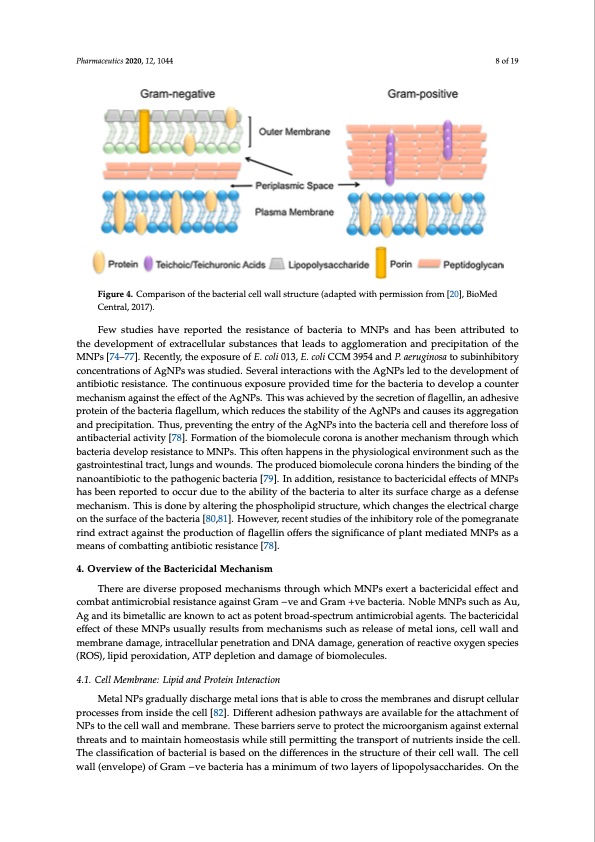
PDF Publication Title:
Text from PDF Page: 008
Pharmaceutics 2020, 12, x FOR PEER REVIEW 8 of 20 inhibitory role of the pomegranate rind extract against the production of flagellin offers the Pharmaceutics 2020, 12, 1044 8 of 19 significance of plant mediated MNPs as a means of combatting antibiotic resistance [78]. Figure 4. Comparison of the bacterial cell wall structure (adapted with permission from [20], BioMed Figure 4. Comparison of the bacterial cell wall structure (adapted with permission from [20], BioMed the development of extracellular substances that leads to agglomeration and precipitation of the Central, 2017). Central, 2017). Few studies have reported the resistance of bacteria to MNPs and has been attributed to 4. Overview of the Bactericidal Mechanism There are diverse proposed mechanisms through which MNPs exert a bactericidal effect and MNPs [74–77]. Recently, the exposure of E. coli 013, E. coli CCM 3954 and P. aeruginosa to subinhibitory combat antimicrobial resistance against Gram −ve and Gram +ve bacteria. Noble MNPs such as Au, concentrations of AgNPs was studied. Several interactions with the AgNPs led to the development of Ag and its bimetallic are known to act as potent broad-spectrum antimicrobial agents. The antibiotic resistance. The continuous exposure provided time for the bacteria to develop a counter bactericidal effect of these MNPs usually results from mechanisms such as release of metal ions, cell mechanism against the effect of the AgNPs. This was achieved by the secretion of flagellin, an adhesive wall and membrane damage, intracellular penetration and DNA damage, generation of reactive protein of the bacteria flagellum, which reduces the stability of the AgNPs and causes its aggregation oxygen species (ROS), lipid peroxidation, ATP depletion and damage of biomolecules. and precipitation. Thus, preventing the entry of the AgNPs into the bacteria cell and therefore loss of antibacterial activity [78]. Formation of the biomolecule corona is another mechanism through which 4.1. Cell Membrane: Lipid and Protein Interaction bacteria develop resistance to MNPs. This often happens in the physiological environment such as the gastrointestinal tract, lungs and wounds. The produced biomolecule corona hinders the binding of the Metal NPs gradually discharge metal ions that is able to cross the membranes and disrupt nanoantibiotic to the pathogenic bacteria [79]. In addition, resistance to bactericidal effects of MNPs cellular processes from inside the cell [82]. Different adhesion pathways are available for the ahtatsacbhemenenrtepoofrNtePdstotohcecucerldlwuealtloatnhdemabeimlitbyraonfet.hTehbeascetberairariteorsaslterrvietstosuprfoatceectcthaergmeicarsoaordgeafneinssme amgeacihnastneisxmte.rnTahlisthisredaotsnaenbdy taoltmerainingtathine hpohmosepohsotalsipisidwshtirluecsttuilrlep, werhmicithticnhgatnhgeetsrathnespeolercttorifcnaluctrhiaerngtes ionsitdhesthuerfcaeclel.oTfhtheecblascsteifriica[t8io0n,8o1]f.bHacotwereivaelri,srebcaesnetdsotundtiheseodfiftfhereinhciebsitionrythreolsetroufcthuerepomftehgeriarncaetlel wrinadll.exTthraectcaegllainwstaltlhe(epnrvoedluocpteio)noffflGargaemllin−ovffeerbsatchtersiaignhifiascanacemoifnpimlaunmtmeodfiattwedoMlaNyPerssasoaf lmipeoapnosloyfsaccocmhbaraitdtiensg. Oantibthioetiocthresrishtancde, [t7h8a]t. of Gram +ve bacteria is basically thicker. Gram +ve bacteria has a thick layer of peptidoglycan within their cell walls while Gram −ve bacteria have a thin 4. Overview of the Bactericidal Mechanism layer of peptidoglycan with an extra outer membrane embedded lipopolysaccharide. This additional memTbhraenreianreGdraivmer−sveepbraocptoersieadmeeacnhsatnhiastmthsetrheroisuaglhsowahniecxhtrMaNmPesmebxrearntealabyaecrtetreircmideadlpeffereicptlasnmd (cFoimgubraet4a)n.tSimeviecroalbriaelsereasricshtawncoerkasghaianvsetrGerpaomrte−dvethantdGGrarmam+v+evbeabcatecrteiariar.eNmoobrleMreNsisPtsansutctohMasNAPus, Amgecahnadnitssmbsimofetacltliconar[e8k3n–8o7w].nTthoiascitsadsupeoteonthberodaifdf-esrpeencttrcuemllwanatlilmstircurocbtuiarlea.gInenGtsr.aTmhe−vbeacbtearcitceirdial, seuffcehctaosfEt.hceoslei, Ma 1N–P3sμumsulaylleyrrtehsiuckltsofrloipmopmoelychsacncihsamrisdseuscchovaserrethleacsellosf, imneatdaldiotinosn, tcoel8l wnmallthaincdk lmayeemrborfapnepdtaidmoagglye,ciantsr.aTcehlilsulfarciplietnateetrsatthioenpanssdaDgeNoAf idoanms fargoem, gNenPesraintitonthoef rceallctwivheeorexaysgeGnrasmpec+ivees bacteria like S. aureus have a thicker peptidoglycan layer, which stretches over 80 nm with covalently (ROS), lipid peroxidation, ATP depletion and damage of biomolecules. bound teichoic and teichuronic acids. The damage to the cell membrane of bacteria that happens from 4.1. Cell Membrane: Lipid and Protein Interaction the interaction between the cells and MNPs becomes more harmful to the Gram-negative bacteria. This is due to the absence of a thick protective layer of peptidoglycan as seen with Gram +ve bacteria Metal NPs gradually discharge metal ions that is able to cross the membranes and disrupt cellular Furthermore, Gram −ve bacteria susceptibility to MNPs is due to their negatively charged processes from inside the cell [82]. Different adhesion pathways are available for the attachment of lipopolysaccharide. This causes an attraction to the positive ions released by most MNPs. The NPs to the cell wall and membrane. These barriers serve to protect the microorganism against external consequent effect is an accumulation of ions that leads to intracellular damage. However, it is known threats and to maintain homeostasis while still permitting the transport of nutrients inside the cell. that both Gram +ve and Gram −ve bacteria have a negatively charged cell wall that allows for The classification of bacterial is based on the differences in the structure of their cell wall. The cell wall (envelope) of Gram −ve bacteria has a minimum of two layers of lipopolysaccharides. On thePDF Image | Bactericidal Antibacterial Mechanism of Plant Nanoparticles

PDF Search Title:
Bactericidal Antibacterial Mechanism of Plant NanoparticlesOriginal File Name Searched:
pharmaceutics-12-01044-v2.pdfDIY PDF Search: Google It | Yahoo | Bing
Turbine and System Plans CAD CAM: Special for this month, any plans are $10,000 for complete Cad/Cam blueprints. License is for one build. Try before you buy a production license. More Info
Waste Heat Power Technology: Organic Rankine Cycle uses waste heat to make electricity, shaft horsepower and cooling. More Info
All Turbine and System Products: Infinity Turbine ORD systems, turbine generator sets, build plans and more to use your waste heat from 30C to 100C. More Info
CO2 Phase Change Demonstrator: CO2 goes supercritical at 30 C. This is a experimental platform which you can use to demonstrate phase change with low heat. Includes integration area for small CO2 turbine, static generator, and more. This can also be used for a GTL Gas to Liquids experimental platform. More Info
Introducing the Infinity Turbine Products Infinity Turbine develops and builds systems for making power from waste heat. It also is working on innovative strategies for storing, making, and deploying energy. More Info
Need Strategy? Use our Consulting and analyst services Infinity Turbine LLC is pleased to announce its consulting and analyst services. We have worked in the renewable energy industry as a researcher, developing sales and markets, along with may inventions and innovations. More Info
Made in USA with Global Energy Millennial Web Engine These pages were made with the Global Energy Web PDF Engine using Filemaker (Claris) software.
Infinity Turbine Developing Spinning Disc Reactor SDR or Spinning Disc Reactors reduce processing time for liquid production of Silver Nanoparticles.
| CONTACT TEL: 608-238-6001 Email: greg@infinityturbine.com | RSS | AMP |